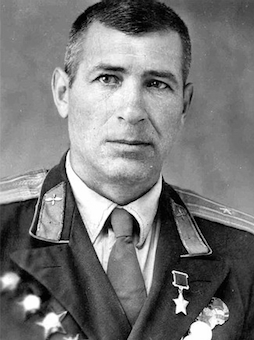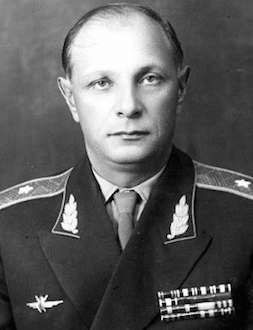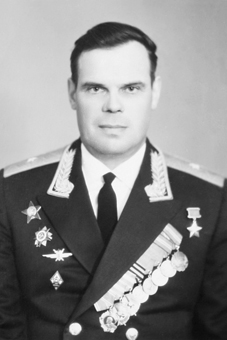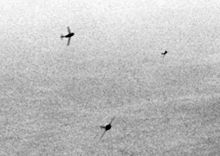
The Air Defense Artillery Branch is the branch of the United States Army that specializes in anti-aircraft weapons. In the U.S. Army, these groups are composed of mainly air defense systems such as the Patriot Missile System, Terminal High Altitude Area Defense (THAAD), and the Avenger Air Defense system which fires the FIM-92 Stinger missile.

The attack on the Sui-ho Dam was the collective name for a series of mass air attacks during the Korean War on thirteen hydroelectric generating facilities by United Nations Command air forces as part of the North Korean bombing campaign on June 23–24 and June 26–27, 1952. Primarily targeting the hydroelectric complex associated with the Sui-ho Dam in North Korea, the attacks were intended to apply political pressure at the stalled truce negotiations at Panmunjeom.

Nikolai Vasilyevich Sutyagin was a Soviet fighter pilot in the Second World War and the Korean War. He is considered by most Russian sources to be the top ace of the Korean War, with 22 victories.

Yevgeny Georgievich Pepelyaev a Soviet fighter pilot in the Korean war; most Russian sources credit him as the second-highest scoring pilot in the war with 19 shootdowns, placing him only below Nikolai Sutyagin. However, some Western sources indicate him to be the top ace of the war, and he claimed to have 23 victories in his memoir, which would put him above Sutyagin's 22 shootdowns.

Lev Kirillovich Shchukin was a Soviet MiG-15 flying ace during early phase of the Korean War. After being badly injured from bailing out of his stricken plane he continued to serve as an officer in the Soviet Air Force and was sent to various communist countries as a military adviser.

Dmitry Pavlovich Oskin was a Soviet MiG-15 pilot and flying ace during the Korean War credited with 11 to 19 solo victories.

Grigory Ivanovich Ges was a Soviet Air Force officer who became a flying ace during the Korean War.

Stepan Antonovich Bakhayev was a Soviet Air Force major, flying ace and Hero of the Soviet Union. Credited with 13 shootdowns during World War II, he went on to fly during the Korean War and was subsequently credited with shooting down 11 American planes during the conflict, although many of the aircraft he was credited with shooting down were able to return to base after sustaining the damage he inflicted.
The 256th Fighter Aviation Regiment was a fighter aviation regiment of the Soviet Air Forces. It existed between 1950 and 1959 and fought in the Korean War.
The 940th Fighter-Bomber Aviation Regiment was an aviation regiment of the Soviet Air Force. It was formed in 1942 in the Soviet Far East and fought in the Soviet invasion of Manchuria. During the last months of the Korean War, the regiment was relocated to China, but did not fight in combat due to the end of the war. After the end of the latter it was transferred to Belarus, where it served for the remainder of the Cold War, being converted into a fighter-bomber regiment in 1960.
The 64th Group Army, former 64th Corps and 64th Army Corps, was a military formation of China's People's Liberation Army that existed from 1949 to 1998.
The 180th Guards Fighter Aviation Regiment was a military unit of the Red Army Air Force, which took part in the fighting of the Great Patriotic War, and then became part of the Russian Air Defence Forces and finally the Russian Air Force.
The 4th Independent Air Defence Army was an army of the Soviet Air Defence Forces. It was formed on 10 April 1960 from the Uralskaya Air Defence Army at Sverdlovsk, Sverdlovsk Oblast. It carried the Military Unit Number 10866.
The 726th Fighter Aviation Regiment was an aviation regiment of the Soviet Air Forces and the Soviet Air Defense Forces.

The 177th Fighter Aviation Regiment PVO was a fighter regiment of the Soviet Air Defense Forces during World War II and the Cold War, later becoming part of the Russian Air Defense Forces and finally the Russian Air Force.
The Moscow Air Defense Front was an air defense front of the National Air Defense Forces, responsible for the air defense of Moscow during World War II. It was formed in April 1942 in response to predictions of a German bomber concentration against Moscow, and its units were used to cover troops and rear areas on the front after the halting of German air raids against that city. In June 1943 it was reorganized as the Special Moscow Air Defense Army.

Sergey Fyodorovich Vishnyakov was a Soviet Air Force officer who fought in World War II and the Korean War, and one of the few pilots considered a flying ace of both wars. He was killed in a flying accident in Bulgaria in 1958.
The 162nd Fighter Aviation Regiment was a fighter regiment (IAP) of the Soviet Air Force during World War II that became part of the Soviet Air Defense Force (PVO) during the Cold War as the 162nd Fighter Aviation Regiment PVO. It was disbanded in 1959 during the reorganization of the PVO.

Ivan Afanasevich Suchkov was a Soviet flight instructor and fighter pilot who was credited as a flying ace with 10 shootdowns in the Korean War.

Grigory Ivanovich Pulov was a Soviet air force officer in command of the 17th Fighter Aviation Regiment during the Korean War. Credited with an estimated eight to ten aerial victories over Korea, he was awarded the title Hero of the Soviet Union on 22 April 1952 for his achievements during the war.












